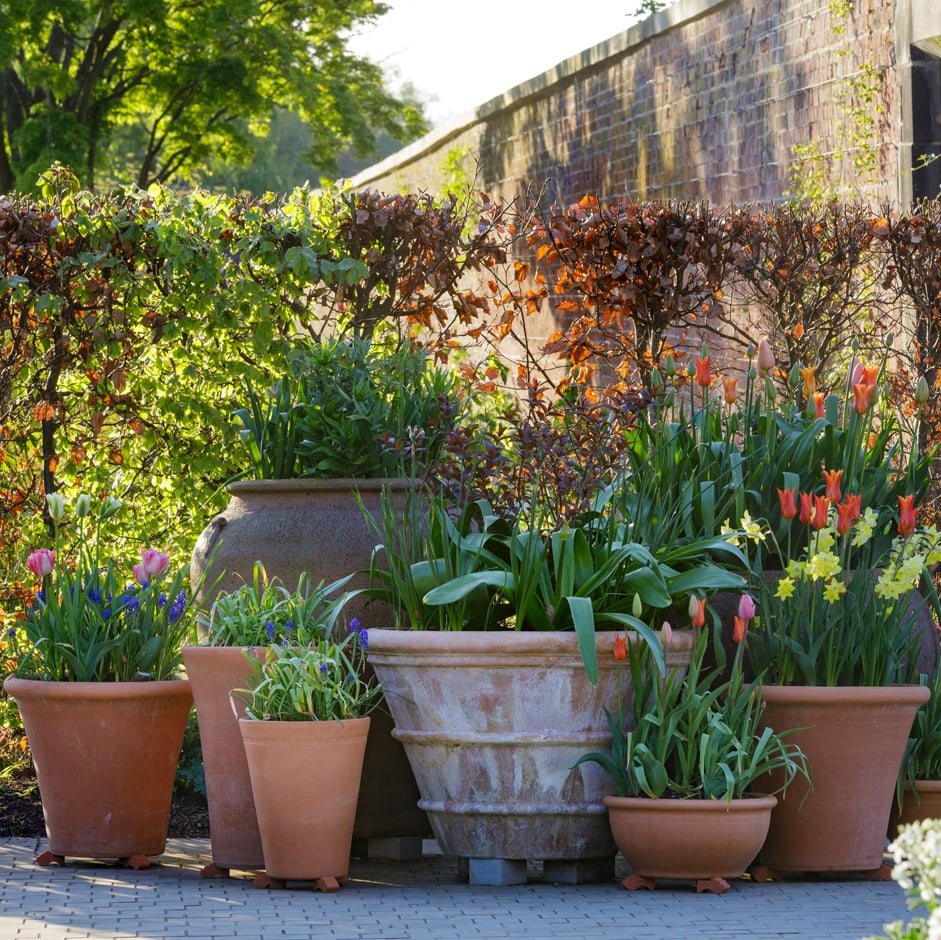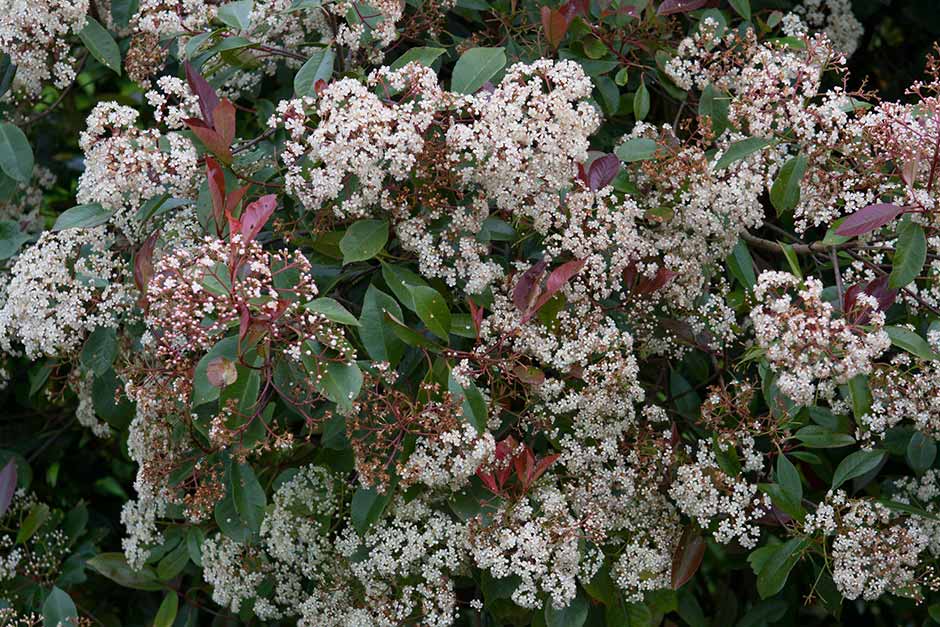Growing guide
How to grow photinia
Photinias are low-maintenance shrubs or small trees, many of which have colourful foliage displays in spring/summer or autumn. They also produce clusters of small white flowers, followed by red berries. The most popular cultivar, Photinia x fraseri 'Red Robin', is prized for its striking ruby-red new foliage.
Quick facts
- Easy-to-grow shrubs or small trees
- Flower in late spring/early summer
- Plant from autumn through to spring
- Like sun or partial shade
- Some dislike alkaline soil
- May be evergreen or deciduous
- Popular as hedging or standalone specimens
All you need to know
What are photinias?
Photinias are shrubs or small trees from China. There are several species, some are evergreen and others
Deciduous refers to plants (mainly trees and shrubs) that lose their leaves seasonally, usually during autumn. This is a natural process triggered by the season's shorter days and lower temperatures and allows plants to conserve energy during the winter months.
The most widely grown photinia is P. × fraseri 'Red Robin', which is an evergreen shrub notable for its rich red young leaves.
Choosing the right photinia for you
There are several species to choose from, offering colourful seasonal foliage displays, clusters of small white flowers and red berries. They suit many styles of garden, either formal or informal, large or small, and can be grown as specimen trees or shrubs, hedges and wall shrubs.
Some species need neutral or acid conditions, so will not grow well in chalky/alkaline soil. They can also be grown in large containers if your soil is unsuitable. See our guide to understanding soil pH.
Some photinias can grow quite large, up to 5m (15ft) after 10 or more years, so check the eventual size before buying. Give larger species plenty of space or be prepared to prune annually.
Photinia × fraseri 'Red Robin', the most widely available form, makes a striking ornamental shrub, especially in spring and summer with its red young foliage. It can be grown as a standalone shrub or a hedge, as its evergreen foliage makes a dense year-round screen.
Attracting wildlife
Evergreen shrubs make useful, sheltered nesting sites for birds in early spring.
How and what to buy
There are several species of photinia, but cultivars of Photinia × fraseri are the most readily available. ‘Red Robin’ is the most popular of these and is widely sold by garden centres and online suppliers, including the RHS Shop.
‘Red Robin’ has glossy evergreen leaves all year round, and rich red new foliage. It also produces a froth of small cream flowers from late spring. Once established, this shrub will grow fast, but regular clipping can keep it down to size and also stimulate colourful new shoots. A smaller version called 'Little Red Robin' grows to about 1.5m (5ft) tall.
A few other species and cultivars can be found on sale, usually in specialist tree and shrub nurseries, including:
- P. davidiana – evergreen shrub with clusters of small white flowers in spring, followed by red berries. Dislikes chalky/alkaline soil.
- P. beauverdiana – deciduous tree with red foliage in autumn, white spring flowers and red berries. Dislikes chalky/alkaline soil.
- P. serratifolia Pink Crispy – bright pink young leaves that are later marbled light and dark green. White flowers in summer, followed by small red fruits.
- P. villosa – small deciduous tree with white flowers in early summer, red fruits, and red/orange autumn foliage. Dislikes chalky/alkaline soil.
For more on the various species, including photos, growing advice and where to buy them, go to RHS Find a Plant and search for ‘Photinia’.
Before buying, always check plant labels or descriptions to ensure the plants you choose will thrive in your garden. See our guide to assessing your garden's conditions.
Guide to buying trees and shrubs
Where to plant
Photinias grow best in fertile, humus-rich soil that is moist but well drained. They are tolerant of most soil types – even clay, as long as you add plenty of well-rotted garden compost or manure before planting. See our guide to identifying your soil type.
Most species are happy in acid or alkaline conditions, but Photinia beauverdiana and P. villosa in particular will not grow well in chalky soil, needing neutral to acid conditions.
Photinias like sun or partial shade – flowering and leaf colour are usually best in full sun. They also prefer a sheltered position. The young shoots can become scorched by cold or drying winds and late frosts if grown in an exposed site. In colder regions, photinias can be grown as wall shrubs, thriving in the extra shelter and warmth.
They are often planted in borders or as standalone specimens, but can also be grown in large containers, and Photinia × fraseri 'Red Robin' in particular is often used as a hedge.
Helping hedgehogs
Hedges can form useful wildlife corridors, offering sheltered routes between gardens for many creatures, including hedgehogs.
When to plant
Photinias are best planted from autumn through to spring, whenever the ground is not frozen or waterlogged. However, they can be planted at other times of year as long as the soil around the roots is watered to keep it moist.
How to plant
Photinias are easy to plant and should settle in well and thrive for many years. Simply follow our guide to planting trees and shrubs or our guide to planting hedges.
Photinias are usually planted in the ground, but cultivars of P. × fraseri, in particular, can be grown in containers, if pruned to keep them compact. See our guide to growing trees and shrubs in containers.

Guide to planting containers
Step-by-step guide to planting shrubs
Photinias are low-maintenance plants that should look after themselves once settled in.
Watering
- After planting, water regularly for at least the first two years
- Once established, they should cope well without extra watering, except in particularly hot, dry spells
- When grown as a wall shrub, photinia may need regular watering if it’s sheltered from rainfall
- Plants in containers can dry out quickly, so should be watered regularly during the summer
Tips on recycling and collecting water
How to water efficiently
Feeding
Photinias don’t generally need additional feeding, except on poor soils or to encourage more growth. In which case, scatter a general-purpose fertiliser, such as Growmore, on the surrounding soil in spring, at the dose stated on the packet. See our guide to fertilisers.
Plants in containers need regular feeding, as most composts run out of nutrients after a few months. See our guide to container maintenance.
How and what to feed plants
Mulching
Applying a thick layer of mulch, such as well-rotted garden compost or manure, around the base will help to suppress weeds and hold moisture in the soil.
Apply it when the ground is damp, in spring or autumn. Leave a 10cm (4in) gap around the stem, to avoid any risk of rotting the bark. Top up annually.
Caring for older plants
Photinias are long-lived plants that can grow quite large over time. If your photinia has become overgrown or outgrown its space, you can renovate it by cutting back hard to a low framework, then thinning out any congested shoots as they grow back.
You should renovate deciduous forms in winter, and evergreens in spring.
See our guide to renovative pruning.
How to sharpen pruning tools
Photinias require minimal pruning, but will benefit from the occasional trim in spring or summer to promote dense growth and maintain a good overall shape. Vigorous species can be pruned more regularly to keep them within bounds.
Avoid trimming after mid-August, as regrowth would be vulnerable to autumn frosts.
For general advice on pruning evergreen photinias, see our guide to pruning evergreen shrubs.
Tips on pruning Photinia × fraseri ‘Red Robin’:
- This is a vigorous cultivar and can grow up to 30cm (1ft) in a year, so keep it under control and encourage bright young leaves by shortening stems by up to 15cm (6in), cutting just above an outward-facing bud
- When grown as a hedge, remove the tips of young shoots to encourage the bright red leafy re-growth. It can be trimmed up to three times a year
- Ideally prune with secateurs rather than a hedgetrimmer, to avoid slicing through the leaves. Make your cuts just above a leaf joint
For advice on pruning deciduous photinias, such as P. villosa and P. beauverdiana, see our guide to light pruning.
Photinia cultivars, such as P. × fraseri 'Red Robin', are best propagated by softwood cuttings in early summer or semi-ripe cuttings in summer and autumn. This will ensure the new plants are exactly the same as the parent.
Photinia species, such as P. villosa and P. davidiana, can also be grown from seed, sown in spring after stratification. Chilling may improve germination.
How to collect and store seeds
Photinias are generally healthy and trouble-free when grown in good conditions. However, cold, exposed or damp locations may lead to the following:
- Frost or wind damage – late frosts and cold winds may shrivel or kill soft new shoots
- Leaf spot – purple-brown spotting on foliage is a sign the plant is under stress, often due to cold, wet winters. Recently planted large specimens are particularly prone, as they take longer to establish than younger plants
- Yellowing leaves due to nutrient deficiency on alkaline soil – some species, including Photinia beauverdiana, need neutral or acidic soil
Any damaged foliage will fall away naturally in spring or early summer, sometimes with heavy leaf loss. These are usually soon replaced, but plants may become thinner in the centre. To restore, cut back some of the stems in early May/June to encourage younger, more leafy shoots.
To avoid these problems:
- Choose a warm, sheltered location, rather than exposed or frost-prone sites
- Plant younger specimens, which should establish more quickly
- Position against a sunny wall for extra shelter, especially in colder regions
- Dig in organic matter before planting to aid drainage, especially if your ground is heavy
- Choose photinia species that will thrive in your soil, particularly if you have alkaline or chalky soil, or grow them in containers. Check plant labels carefully before buying, and see our guide to testing your soil pH
Pests and diseases
Photinias attract few pest and diseases, but you may occasionally find:
- Powdery mildew – a fungal disease that can appear as purple blotching on foliage
- Fireblight – this bacterial disease causes shoots to shrivel and die. It can occasionally affect certain photinia species, including P. villosa and P. davidiana
- Wine weevil – these may feed on the leaves, producing distinctive notches in leaf margins
Controlling pests and diseases without chemicals
Tips on avoiding pest and disease problems

Discover photinia
Everything you need to know about choosing the right photinia for you.
Get involved
The Royal Horticultural Society is the UK’s leading gardening charity. We aim to enrich everyone’s life through plants, and make the UK a greener and more beautiful place.